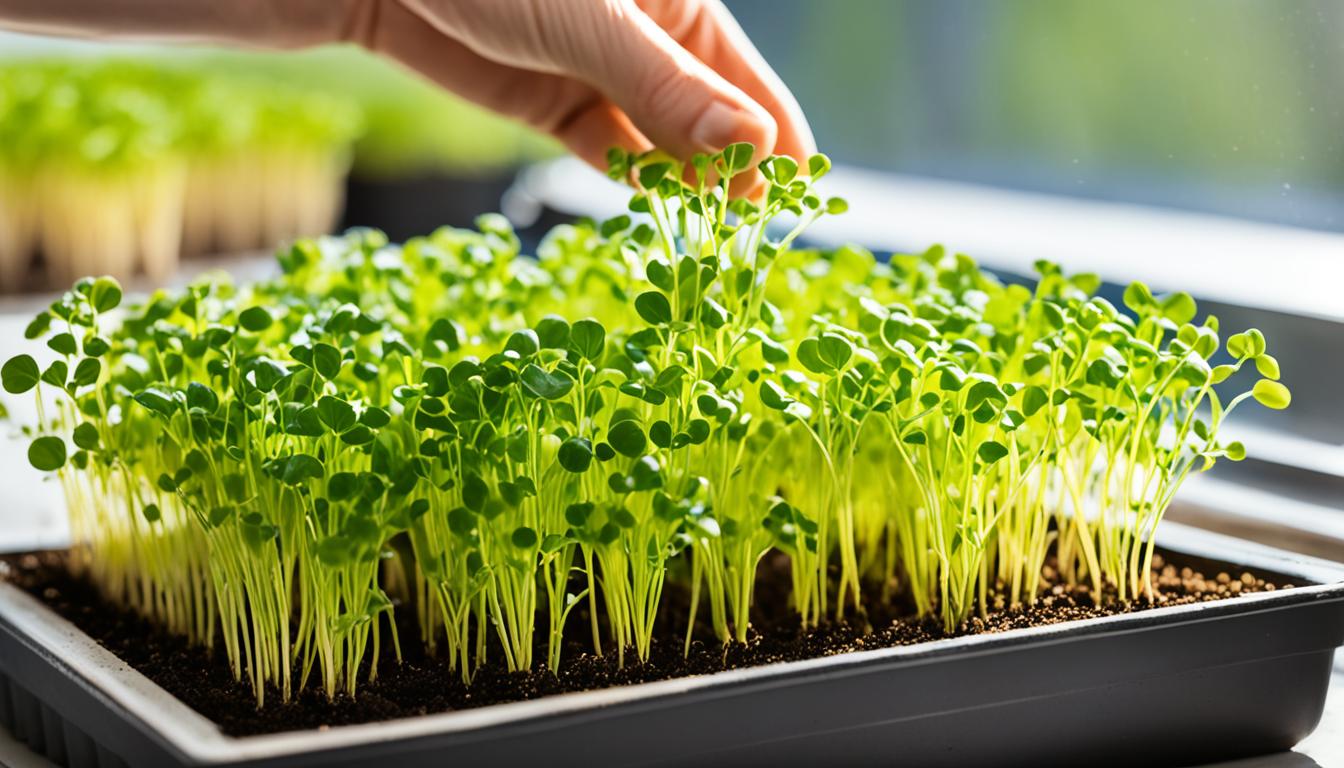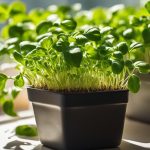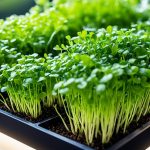Expand your culinary garden with the zesty addition of mustard microgreens, a flavorful and nutrient-rich green that’s surprisingly simple to cultivate right at home. These tiny plants pack a punch similar to the tang of ranch dressing and are an excellent source of vitamins A, B6, C, K, E, along with minerals like calcium, fiber, and potassium.
Whether you’re a seasoned gardener or just starting out, our easy mustard green growing and mustard microgreen care tips will help you achieve a bountiful harvest. Delve into the world of growing mustard microgreens with our comprehensive guide and elevate the flavors of your homemade dishes with your own home-grown produce.
Introduction to Mustard Microgreens
Mustard microgreens, the petite yet powerful relatives of mature mustard plants, represent a remarkable fusion of flavor and nutrients that can easily be grown at home. Much more than a garnish, these greens embody a full-bodied, peppery taste akin to that of the mustard we all know, yet come packed with a much denser nutritional profile. Gain a savory sprout of sophistication in your dishes while lavishing your body with their extensive health benefits.
The Flavorful Punch of Mustard Microgreens
Anyone seeking a zesty addition to their culinary palette need not look further than mustard microgreens. Despite their diminutive size, these greens deliver a robust, spicy, and at times sweet flavor profile reminiscent of bottled mustard. Their distinctive white stems bleed into pale green cotyledons, making them not only a feast for the tastebuds but also a visual delight.
Nutritional Powerhouse: Mustard Microgreen Benefits
When it comes to mustard microgreen nutrition, these youthful greens are giants. They overshadow many traditional store-bought vegetables with their elevated content of vitamins A, C, E, and K, alongside a boost of calcium and potent antioxidants. What’s more, for those managing diabetes, incorporating mustard greens into a balanced diet can play a supportive role in maintaining overall health and wellness.
Mustard Microgreens vs. Mature Mustard Plants
Understanding the distinction between mustard microgreens and their full-grown counterparts, the mature mustard plants, is essential. While both share certain characteristics and health benefits, the microgreens variation stands out. They are harvested at an earlier stage of growth, which provides a more concentrated nutrient profile and ensures that you’re reaping the maximum mustard microgreen benefits in every bite.
Choosing the Best Varieties of Mustard Microgreens for Your Garden
For gardening aficionados seeking to add both zest and beauty to their edible landscapes, selecting the best variety of mustard microgreens is crucial. Each variety presents unique flavors and visual appeal, promising a dazzling microgreen experience from garden to plate.
Spotlight on Red Garnet Mustard Microgreens
Stealing the show with its vibrant color profile, Red Garnet mustard microgreens are more than just a pretty addition to your microgreen collection. The deep reddish-purple hue of their lush leaves not only enhances the aesthetic of dishes but also indicates a potent blend of taste and nutrition. This variety brings a gentle heat and decorative flare, ideal for gourmet garnishes or a pop of color in your salads and sandwiches.
Exploring Spicy Oriental Mustard Microgreens
If your palate favors bolder flavors, then the pungent kick of Spicy Oriental mustard microgreens will not disappoint. These microgreens bring an assertively sharp taste that can hold its own in any dish. An inviting characteristic of the Spicy Oriental variety is its ease of preparation, as these microgreens skip the presoaking step that others often require. Their spicy savor is perfect for spice lovers looking to elevate their culinary creations.
Other Popular Mustard Varieties Worth Trying
Beyond the red and fiery, other mustard microgreen varieties, such as Mizuna, Osaka Purple, and Southern Giant Curled, offer a spectrum of flavors and appearances. True Leaf Market stands as a reputable purveyor of these high-quality seeds, providing gardeners with ample choice to personalize their microgreen gardens. Whether you’re into subtle earthy tones or distinctive sharp tastes, there’s a mustard microgreen variety waiting to transform your garden and your taste buds.
Essential Supplies for Growing Mustard Microgreens
Embarking on the journey of cultivating mustard microgreens starts with assembling the right tools and ingredients for success. The essentials include a combination of reliable equipment and the best consumables that will support the growth of robust and flavorful greens.
Trays, Containers, and Grow Lights
Central to the endeavor are trays and containers specifically designed for microgreen cultivation. These should foster proper root development and drainage. An impactful addition to this setup is grow lights for microgreens. Whether you choose LED panels or T5 fluorescent tubes, make sure the lighting system provides an even, full-spectrum light to mimic the natural solar conditions, essential for the chlorophyll production in your mustard greens.
High-Quality Microgreen Seeds from Trusted Sources
What can be more vital to the process than the seeds themselves? Selecting mustard microgreen seeds of the highest quality ensures a high germination rate and ultimately, a bountiful harvest. Reputable sellers like True Leaf Market offer an array of premium, non-GMO seeds that cater to both beginner gardeners and seasoned growers of microgreens.
The Importance of Using the Right Growing Medium
Lastly, considering the growing medium can be just as important as the seeds you sow. Espoma Seed Starter Mix, with its fine texture and nutrient-rich composition, provides an excellent foundation for mustard seeds to sprout and thrive. A suitable medium not only supports the initial stages of growth but also influences water retention, nutrient availability, and the overall health of the microgreens.
The harmony of these growing mustard microgreens supplies creates an environment where your mustard microgreens can flourish, setting the stage for a successful and enjoyable growing experience.
Step-by-Step Guide on How to Grow Mustard Microgreens
Embarking on the journey to grow mustard microgreens step by step requires precision, care, and a little bit of green thumb intuition. Whether you’re a seasoned gardener or a curious novice, mustards are a foolproof pick for a crisp, nutritious addition to your table. Let’s explore the stages of nurturing these spicy greens from seeding to thriving.
Preparing Your Trays and Soil for Planting
Before you begin sowing mustard seeds for microgreens, the groundwork is all about preparing trays for mustard microgreens. A shallow tray, ideally an inch or two deep, makes an excellent start. Opt for a fine-grained growing medium such as coconut coir, which is known for its superior water retention and breathability. Fill the tray loosely to allow room for tender roots to penetrate and breathe. This preparatory step sets the stage for robust growth.
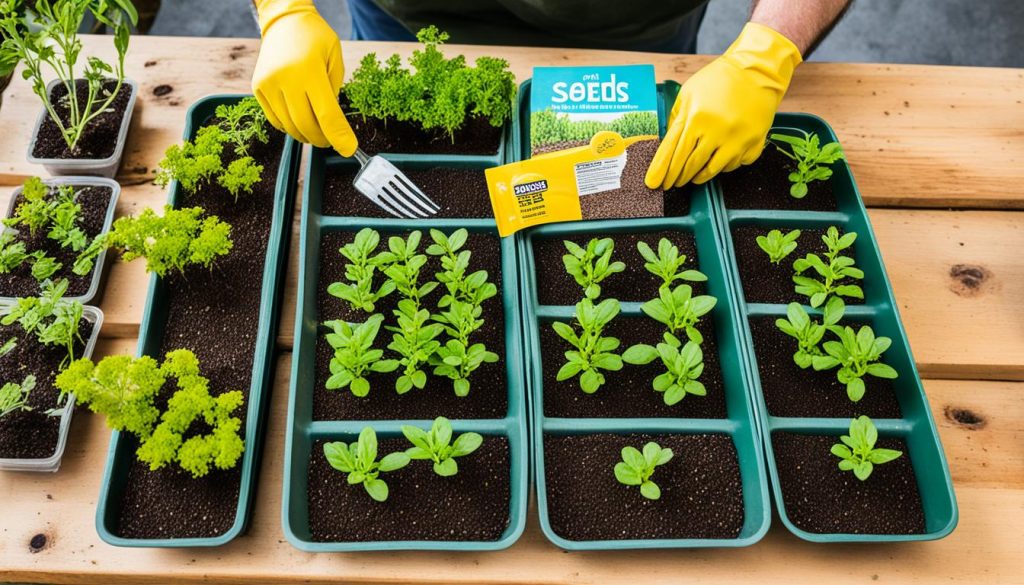
Sowing Mustard Microgreen Seeds Correctly
The art of sowing mustard seeds for microgreens lies in the even scattering across the surface of your prepared tray. Overcrowding can lead to poor air circulation and potentially, fungal issues, so aim for a sprinkle that gives each seed its own space to flourish. Once scattered, press the seeds gently into the medium and blanket them with another inverted tray. This makeshift cover should be coupled with a light weight—nothing too heavy, just enough to press the seeds into their new bed, signaling the start of germination.
Growing mustard microgreens at home is a rewarding, flavorful endeavor. With just a few simple steps and a sprinkle of patience, you’ll be garnishing your dishes with your very own homegrown zing in no time.
Tips for Mustard Microgreen Care During Germination
Mustard microgreen care is essential from the moment you begin planting mustard microgreens. The success of your future harvest hinges largely on the proper management of the germination of mustard microgreens. Let’s walk through a few essential care tips to ensure your mustard microgreens germinate effectively and grow into robust, flavorful plants.
Once you’ve sown your mustard seeds, it’s critical to provide an environment conducive to germination. Start by maintaining darkness using a weighted cover over your seeds. This not only simulates the natural conditions under which seeds sprout but also helps in consolidating the growth medium around them, promoting stronger root development. Remember, this stage typically spans 2-3 days, so patience is key.
Moisture control is another pillar of mustard microgreen care. While the seeds require a moist environment to kickstart the germination process, it is vital to avoid waterlogging. Use a spray bottle to gently mist the soil, ensuring that it remains damp but not saturated. Overwatering can lead to bacterial growth, which would be detrimental to the delicate seedlings.
Given that these tips will set the stage for healthy growth, paying diligent attention during the germination phase will reward you with a bountiful yield of peppery greens. Remember, the effort you put into caring for your mustard microgreens at this vital stage is a direct investment in both the health of your plants and the zestiness of your future dishes.
Lighting and Watering: Keeping Mustard Microgreens Healthy
Mustard microgreen growth relies heavily on two critical factors: the precision of mustard microgreens lighting and the consistency of watering mustard microgreens. A meticulously calibrated grow light setup paired with a diligent watering strategy can lead to a flourishing microgreen yield. Let’s explore how to harness these elements to your advantage.
Optimizing Growth with the Correct Light Setup
When it comes to lighting, mustard microgreens require a balanced spectrum to thrive. Grow lights are the gardener’s best tool for providing a consistent light source, crucial for supporting steadfast photosynthesis. The right setup ensures that all plants get equal exposure, avoiding the legginess and uneven growth often caused by reliance on natural sunlight. A full-spectrum LED panel is often recommended for its energy efficiency and broad coverage, but T5 fluorescent grow lights are also a popular choice among microgreen enthusiasts.
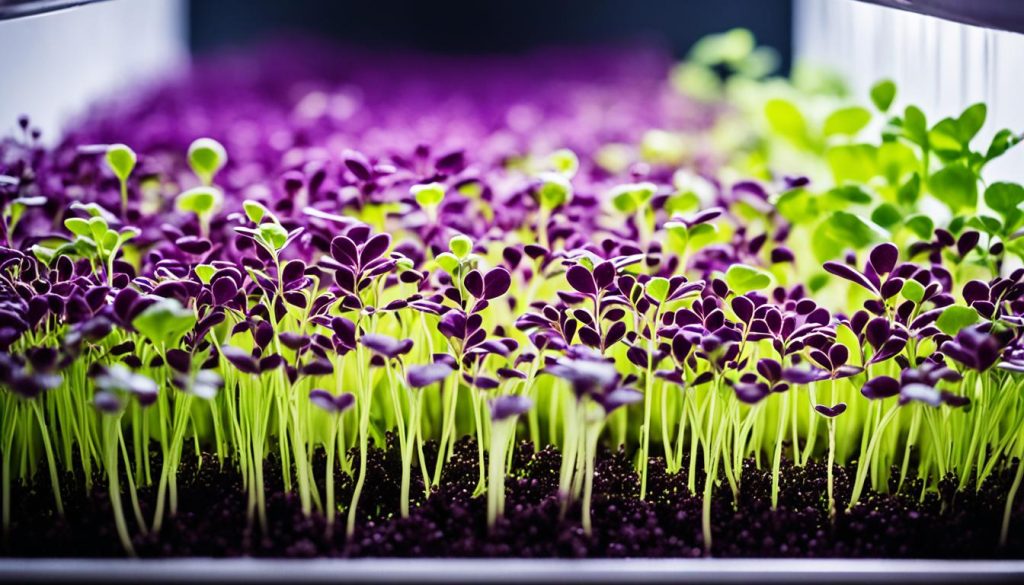
Proper Watering Techniques for Mustard Microgreens
Equally important to mustard microgreens lighting is mastering the art of watering. Too much moisture on the leaves can promote fungal diseases, while too little can stunt growth. The ideal method is bottom-watering, where water is absorbed from below, encouraging roots to grow downward and leaving the foliage dry. This technique not only minimizes disease risks but also fosters a strong and healthy root system, contributing to vigorous overall mustard microgreen growth.
When to Harvest Your Mustard Microgreens
Timing is everything when it comes to harvesting mustard microgreens. These tiny yet powerful greens are best when picked at their peak of flavor and nutrient density. But how can you tell when that moment has arrived? One surefire sign is observing the growth stage of your microgreens. Ideally, you want to aim for that sweet spot between the completion of the cotyledon growth and before the first true leaves form. This typically happens anywhere from 5 to 14 days after planting, depending on factors such as temperature and light.
Identifying the Ideal Time for Harvesting
Observing your greens closely is key to pinpointing the mustard microgreens harvest time. As a grower, look for the telltale signs: the microgreens will stand about 1 to 3 inches tall, and their cotyledons will have wholly unfurled. These youthful leaves carry the intense flavor and crisp texture that make fresh mustard greens such a delight in the kitchen. But be diligent—wait too long, and the first set of true leaves may start to emerge, indicating you’ve missed the optimal harvesting window.
How to Harvest Microgreens for Continued Freshness
The process of harvesting mustard microgreens is a delicate affair that directly impacts their shelf-life and freshness. For a successful harvest, arm yourself with a pair of clean, sharp kitchen shears. Gentle precision is the goal as you clip the greens just above the soil line. This ensures maximum freshness, preserving their peppery punch for your upcoming mustard microgreen recipes. Post-harvest, don’t let the remaining plant material go to waste. The leftover soil and roots are excellent additions to your compost bin, ready to enrich future planting endeavors.
The Culinary Uses of Mustard Microgreens
Exploring the culinary uses of mustard microgreens opens up a world of flavor and nutrition for enthusiasts and chefs alike. As versatile as they are vibrant, these tiny yet mighty greens can transform any dish with their tingling spicy kick, and integrating them into your culinary repertoire can be both exciting and rewarding. The burgeoning trend of homegrown produce has placed mustard microgreens at the frontlines of innovative, fresh, and wholesome cooking.
Incorporating Microgreens into Your Favorite Dishes
Whether you’re jazzing up a classic sandwich or seeking an extra zing in your salads, mustard microgreens are an impeccable choice. The ease of cooking with mustard microgreens means they can be effortlessly added to wraps, blended into smoothies for a nutrient punch, or simply used as an ornamental yet edible garnish. Their usage extends to elevating the textures and flavors in gourmet applications, presenting an easy entry into the realm of sophisticated, health-conscious cuisine.
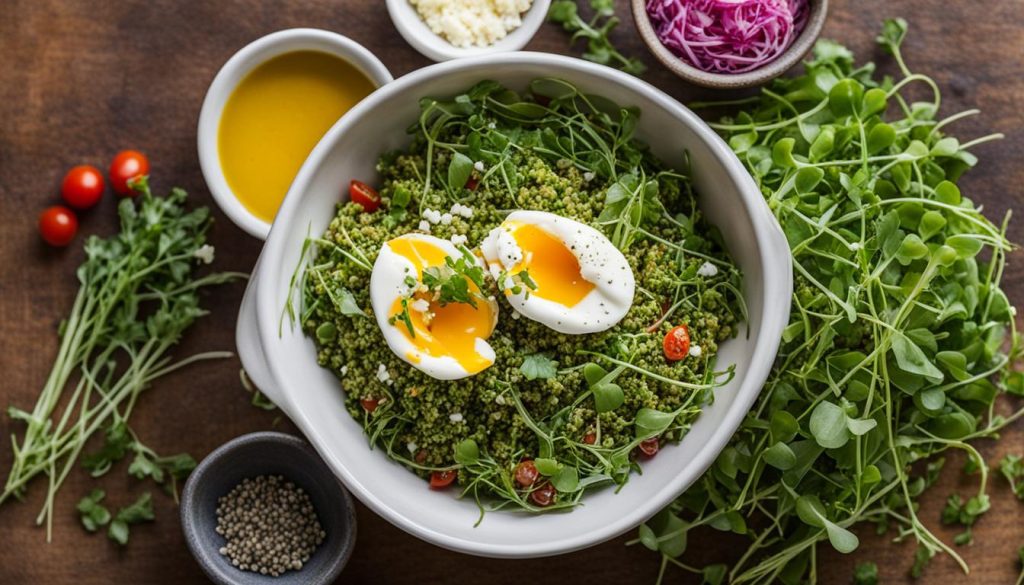
Mustard Microgreen Recipes to Inspire You
For those seeking inspiration, numerous mustard microgreen recipes are readily available to kickstart your journey into the nutritious world of microgreens. Consider a fresh take on pesto, with mustard microgreens replacing basil for a sharp, peppery twist, or incorporate them into a hearty quiche to give a familiar brunch a new lease of life. The beauty of thesegreens lies in their ability to pair well with both the simplicity of a salad and the complexity of exotic dishes, making them a diverse ingredient in the modern kitchen.
Storing and Preserving Your Mustard Microgreen Harvest
Once you’ve reaped the spicy bounty of your mustard microgreens, properly storing mustard microgreens is crucial for maintaining their peppery flavor and nutritional value. These delicate greens require gentle care to preserve their vibrancy from garden to table.
Best Practices for Refrigeration and Shelf Life Extension
To enhance the shelf life of mustard microgreens, cooling them promptly is essential. Firstly, after a light rinse to remove soil, spin the greens dry or let them air-dry. Then, take a plastic bag designed for produce, ensuring it’s dry and free from any debris. By placing a dry paper towel inside, you’ll help to soak up any residual moisture. This step is key in preventing microbial growth and spoilage. Seal the bag lightly, allowing for a small amount of airflow, and place it in the refrigerator. Through proper refrigeration of microgreens, you can expect your mustard greens to stay fresh for up to 10 days.
Handling Precautions for Fresh Mustard Microgreens
To keep microgreens at their peak, handle them as little as possible and with great care. Their fragile structure can easily bruise, compromising both texture and taste. If you must handle your greens, do so with washed and dried hands or use tongs. When preserving mustard greens, always ensure they’re completely dry before storing to prevent wilting and potential rot. Following these precautions will not only prolong the life of your microgreens but also retain the zesty flavor that makes them a favored addition to a myriad of dishes.
Conclusion: Embracing Mustard Microgreens in Your Garden and Kitchen
When you embrace mustard microgreens in your daily life, you’re not just adding a new ingredient to your diet; you’re welcoming a world of rich flavors, robust nutrition, and the joys of home gardening. Mustard microgreens, with their peppery zest and vibrant hues, offer a simple way to enhance both the taste and aesthetic appeal of your meals. It’s no wonder they are celebrated for their mustard microgreen nutrition benefits, including a wealth of vitamins and minerals that contribute to a healthy lifestyle.
The beauty of mustard microgreens doesn’t stop at the plate. The act of starting a microgreen garden provides a fulfilling and educational hobby for food enthusiasts and green thumbs alike. The ease with which these greens can be cultivated at home makes them an ideal choice for those looking to dip their toes into the world of gardening. With a short cycle from seed to harvest, you can experience the satisfaction of eating what you grow, understanding the true meaning of farm-to-table living.
Incorporating mustard microgreens into your culinary creations is not just a step but a leap towards more sustainable, healthful eating. By acknowledging the simple joys of growing and preparing your own greens, you contribute to a greener planet and a more balanced diet. So go ahead, let these tiny yet mighty greens revolutionize the way you eat and think about your food. After all, good things come in small packages, and mustard microgreens are no exception to that rule.
